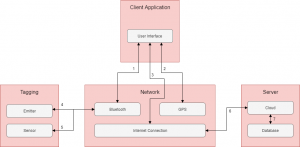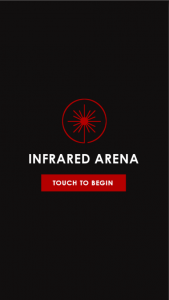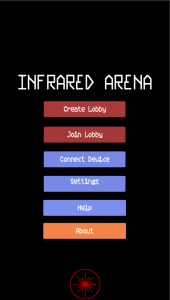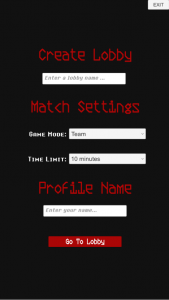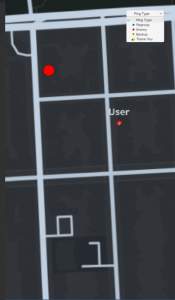Team Name
Infrared
Timeline
Fall 2019 – Spring 2020
Students
- Edgar Acevedo
- Justine Batongmalaki
- Linda Phanvilay
- Danny Vu
- Jean-Marcel Yacho
Sponsor
Shawn Gieser
Abstract
Infrared Arena will allow users to have their own private laser tag matches with their friends. The system will consist of a laser tag gun and Android phone application. The laser tag gun contains an emitter, sensors, bluetooth and phone mount. The Android phone application was created using Unity ver 2019.2.8f1. The app will allow users to create and join multiplayer matches which will be hosted on a cloud server. The intended audience for this system is users 12 and up. The total development costs will not exceed $800.
Background
Our team is focused on building an application that will enable users to play laser tag through their mobile devices, anytime, anywhere. Players will not have to worry about traveling to an indoor or outdoor center or borrowing equipment for a price each time. The laser gun will be a one time purchase and the application itself will be free on the Google Play Store. User’s will be able to connect their mobile devices to the physical laser gun to implement the game. Whether it’s inside or out, users will have the ability to transform their current location into a playing field. This will encourage users to go out and meet their friends, make a team, and wage war against each other without any hassle.
Project Requirements
- Equipment and phone application are able to connect using internet connection and bluetooth.
- Alter existing system and create a better gaming experience.
- App will be connected to a Map API to display mini map.
- Mini map displays location and direction of friendlies using phone GPS of each player.
- User’s can draw game boundaries in the app.
- Ammo and health of player will update on mobile app based off of effects on hardware.
- App is cloud based to allow multiple users to play.
- Teammates can use pings to indicate enemy spotted, missing, rendezvous, and back up.
- App will store data locally on device or on cloud service to reference for scoreboard.
System Overview
- Client Layer
- The client layer represents the smartphone being used to play Infrared Arena. The only subsystem of this layer the mobile application. The app allows users to create or join multiplayer matches. The UI of the app will be constantly updated based on interactions with the other layers of the Infrared Arena systems.The client layer will receive data from the tagging layer through the bluetooth subsystem of the network layer. This data, along with user data collected by the app, will be sent to the cloud layer through the internet subsystem of the network layer. The cloud layer will send back updates to the game state. These updates will be reflected in the UI of the app.
- Server Layer
- The server layer contains 2 subsystems that work together to store data and provide the user with information as needed.The Cloud subsystem provides our computing environment and management of data and resources. It continuously stores, manages, and updates the data which may be received through the user’s GPS and online connectivity. The Database subsystem receives its data through the cloud and also sends information to the user.
- Tagging Layer
- The tagging layer consists of the emitter and sensor subsystem. The emitter subsystem is used to target and tag players, while the sensor subsystem is used to receive the tag.
- Network Layer
- The Network Layer subsystem is in charge of data connection between the Client, Tagging and Server subsystems. Input into the Network layer is through Bluetooth connectivity from the Tagging subsystem to the Client subsystem. The Tagging subsystem determines if user is tagged. The Client subsystem sends data through a internet connection to the Network subsystem which goes to the Server subsystem. The Server subsystem connects users to the laser tag game.
Results
- UI Screens
- Firebase was used as the cloud service provider
- Mapbox was used as to show the map arena and user’s location
- Recoil Laser Tag Kit was the modified system
- Bluetooth between Recoil laser gun and the phone’s bluetooth connects through our app
- Pinging system created for team communication
- Unity 2019.2.8f1 was used to create the app
Future Work
- User Account Creation and Login
- Users can create account using email and password credentials to store their information in a database to reference to save and display statistics about overall game play such as number of kills, number of deaths, number of wins, number of losses, scores of each game, etc.
- Battery Saver Mode
- Different mode of the app that will allow.
- Bug Reports Feature
- Users will be able to report bugs and issues for developers to fix.
- Extra Items
- Landmine and health packets can be placed on the map by the user to effect other players.
Project Files
Project Charter (link)
System Requirements Specification (link)
Architectural Design Specification (link)
Detailed Design Specification (link)
Poster (link)
References
- Recoil Laser Kit – https://www.amazon.com/Recoil-Starter-enabled-Multi-Player-Smartphone/dp/B072548K9T/ref=sr_1_3?keywords=recoil&qid=1572021823&sr=8-3
- Recoil Open Resource Documentation – https://www.theworldisnowgame.com/open-source/

